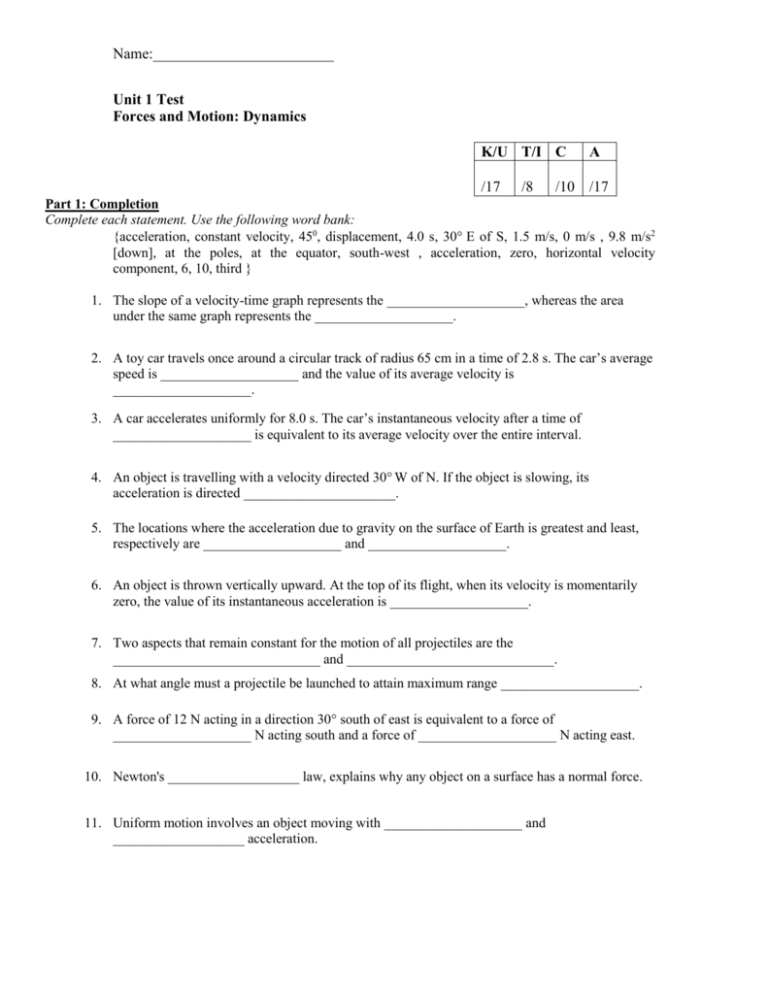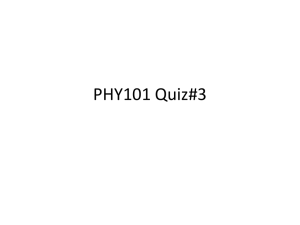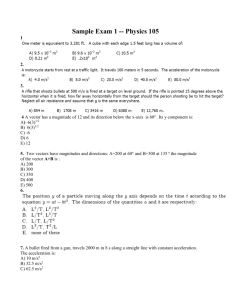File
advertisement

Name:________________________
Unit 1 Test
Forces and Motion: Dynamics
K/U T/I C
/17
/8
A
/10 /17
Part 1: Completion
Complete each statement. Use the following word bank:
{acceleration, constant velocity, 450, displacement, 4.0 s, 30 E of S, 1.5 m/s, 0 m/s , 9.8 m/s2
[down], at the poles, at the equator, south-west , acceleration, zero, horizontal velocity
component, 6, 10, third }
1. The slope of a velocity-time graph represents the ____________________, whereas the area
under the same graph represents the ____________________.
2. A toy car travels once around a circular track of radius 65 cm in a time of 2.8 s. The car’s average
speed is ____________________ and the value of its average velocity is
____________________.
3. A car accelerates uniformly for 8.0 s. The car’s instantaneous velocity after a time of
____________________ is equivalent to its average velocity over the entire interval.
4. An object is travelling with a velocity directed 30 W of N. If the object is slowing, its
acceleration is directed ______________________.
5. The locations where the acceleration due to gravity on the surface of Earth is greatest and least,
respectively are ____________________ and ____________________.
6. An object is thrown vertically upward. At the top of its flight, when its velocity is momentarily
zero, the value of its instantaneous acceleration is ____________________.
7. Two aspects that remain constant for the motion of all projectiles are the
______________________________ and ______________________________.
8. At what angle must a projectile be launched to attain maximum range ____________________.
9. A force of 12 N acting in a direction 30 south of east is equivalent to a force of
____________________ N acting south and a force of ____________________ N acting east.
10. Newton's ___________________ law, explains why any object on a surface has a normal force.
11. Uniform motion involves an object moving with ____________________ and
___________________ acceleration.
Part 2: Matching
Match the calculation with the quantity it determines.
a. velocity
b. acceleration
____
____
____
d. displacement
e. change in velocity
1. the slope of a velocity-time graph
2. the slope of a position-time graph
3. the area under an acceleration-time graph
The diagram below shows two forces acting on an object. Match the components of these forces
with the magnitudes of their values.
a. 5.2 N
b. 4.4 N
____
____
c. 4.3 N
d. 2.5 N
4. F1X
5. F1Y
Match the situations described below with the Newton’s law that best accounts for the motion.
a. Astronauts feel pushed back into their seats during launch.
b. The force an astronaut exerts on his seat is equal in strength and opposite in direction to
the force the seat exerts on the astronaut.
c. The force exerted by the rocket engine overcomes the forces of gravity and air resistance,
resulting in an upward acceleration of the rocket.
____
____
____
6. Newton’s first law
7. Newton’s second law
8. Newton’s third law
2
Part 3: Short Answer (2 M each)
1. In 1976, the province of Ontario made seat belt use mandatory for front seat occupants.
In 1983, seat belt use for rear seat occupants was also made mandatory. Using physics
terms or laws, explain the importance of a seat belt.
2. The force of tension in the cable that is supporting an elevator is 10 000 N. If the weight of the
elevator is 10 000 N, describe the motion of the elevator.
3. An object sits at rest on a ramp inclined at an angle . As the angle of inclination increases, the
object suddenly starts moving. From a discussion of the force involved, explain why.
4. Providing examples of each, differentiate between inertial and noninertial frames of reference.
5. Sketch a graph to show the variation of the force of gravity a pair of objects exert on one another
and the separation distance between the objects’ centres of mass and explain the relationship that
is shown.
3
Part 4: Problems
1. Two blocks are connected by a “massless” string over a “frictionless” pulley as shown in the
diagram.
(a) Determine the acceleration of the blocks.(6M)
(b) Calculate the tension in the string. (2M)
(c) If the string broke, for what minimum value of the coefficient of static friction would the 2.0kg block not begin to slide? (3M)
2. A projectile is launched with a horizontal velocity of 6.0 m/s. It takes 0.61 s to strike the
ground.
a) Determine the height that the projectile falls. (3M)
b) Calculate the horizontal distance travelled by the projectile. (3M)
4
Answer Section
COMPLETION
1. ANS: acceleration, displacement
2. ANS: 1.5 m/s, 0 m/s
3. ANS: 4.0 s
4. ANS: 30 E of S
5. ANS: at the poles, at the equator
6. ANS: 9.8 m/s2 [down]
7. ANS: acceleration, horizontal velocity component
8. ANS: 450
9. ANS: 6, 10
10. ANS: third
11. ANS: constant velocity, zero
MATCHING
1.
2.
3.
4.
5.
6.
7.
8.
ANS:
ANS:
ANS:
ANS:
ANS:
ANS:
ANS:
ANS:
D
A
E
A
B
A
C
B
SHORT ANSWER
1. ANS:
This is an example of Newton’s first law. An object at rest or in uniform motion remains
at rest or in uniform motion unless acted on by an external force. If a car brakes suddenly,
passengers continue to move forward at the car’s original speed until stopped by their
seat belts. Passengers who are restrained by seat belts do not collide with the windshield,
dashboard, or other objects inside or outside the car.
DIF:
average
REF: K/U, I, MC LOC: FM 1.01, FM 1.02
5
2. ANS:
The forces acting on the elevator are balanced, so Fnet 0. The elevator is either at rest or
moving with a constant velocity.
DIF:
easy
REF: K/U, MC
LOC: FM 1.01, FM 1.02
3. ANS:
The force of static friction (FS SFN) is balanced by the component of gravity along the ramp
(mgsin ). As well, the normal force FN is balanced by mgcos the component of gravity
perpendicular to the ramp. As the angle increases, the value of cos decreases, reducing the
value of the static friction force. In turn, the value of sin increases making the value of the
gravitational component along the ramp greater. At some point, this gravitational component
force overcomes the force of static friction and the object begins to slide.
PTS: 1
REF: C
OBJ: 2.4
STA: FM1.01
4. ANS:
An inertial frame of reference is one in which the law of inertia is valid. As such, an object will
remain at rest or in uniform motion unless acted upon by an external, unbalanced force. A car
travelling with constant velocity is an example of an inertial frame of reference. A noninertial
frame of reference is one that is accelerating. Objects in this type of frame of reference do not
appear to obey the law of inertia. If the car suddenly stopped, an object sitting in the back window
would fly forward with no apparent force having acted upon it. Its motion would seem to violate
the law of inertia from its frame of reference.
PTS: 1
REF: C
OBJ: 2.5
STA: FM1.05
5. ANS:
The force of gravity is directly proportional to the mass of the object it is being exerted upon.
The force of gravity varies inversely as the square of the distance between the centres of mass of
the two objects.
PTS: 1
REF: K/U | I
OBJ: 3.3
STA: FM1.06
Part 4 : PROBLEMS
6
1. ANS:
(a)
For the 0.80-kg mass:
Free-body diagram:
FN acting up
Fg acting down
FT acting to the right (this is the positive direction)
FK acting to the left (this is the negative direction)
0.80 kg(a) = FT – KFN
0.80 kg(a) = FT – 0.14(0.80 kg)(9.8 N/kg)
0.80 kg(a) = FT – 1.10 N
For the 2.0-kg mass:
Free-body diagram:
FN acting perpendicular to the ramp (upward)
Fg acting down
FT acting up along the ramp (this is the negative direction)
FK acting up along the ramp
2.0 kg(a) = 2.0 kg(9.8 N/kg)(sin 30º) – FT – 0.14(2.0 kg)(9.8 N/kg)(cos 30º)
2.0 kg(a) = –FT + 7.42 N
Solving the system of equations: a = 2.3 m/s2
The system will accelerate at 2.3 m/s2.
(b)
FT = 0.80 kg(a) + 1.10 N
= 0.80 kg(2.26 m/s2) + 1.10 N
FT = 2.9 N
The tension in the string is 2.9 N.
(c)
If the block remains stationary:
FS = Fg sin
= 2.0 kg(9.8 N/kg)(sin 30)
FS = 9.8 N
The minimum coefficient of static friction required is 0.58.
PTS: 1
REF: K/U
OBJ: 2.3
STA: FM1.01
2. ANS:
a) Consider only the vertical components of the projectile.
vvi = 0, ag = 9.81 m/s2, t = 0.61 s, dv = ?
7
dv = vvit + at2
dv = (9.81 m/s2)(0.61 s)2
= 1.8 m
b) Consider the horizontal components of the projectile.
vh = 6.0 m/s, t = 0.61 s, dh = ?
dh = vh(t)
= (6.0 m/s)(0.61 s)
= 3.7 m
DIF:
easy
REF: K/U
LOC: FM 1.03
8









